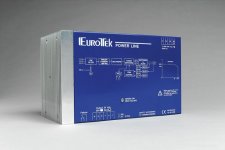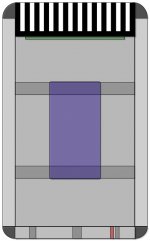Just check the output noise under load with a 'scope. All SMPS's will have *some* residual noise (as do linears) so a little extra output filtering caps wouldn't go astray perhaps, depending on just how good the unit is. Use low esr types that specify the esr at high frequencies. When you get the thing going, please publish the great results and benefits so that the anti-SMPS crowd can put you straight. 
That didn't take long.
I for one would like to hear a really refined amp built with a high quality switcher, just to see how well it works. Rectifier noise in a linear supply can be nasty, yet we seem to be able to handle it without any problem. No reason I can think of that we shouldn't also be able to handle residual switching noise as well. I would pay attention to the physical location of the power supply relative to the amps input wiring and circuitry to avoid inducing noise in low level signals.
Also, I would not just blindly add a lot of external capacitance to any supply, check the manufacturer's literature for recommendations on how to reduce ripple and noise from the output. I'll bet they have an application note on using their products in specialised apps.
Phil
I for one would like to hear a really refined amp built with a high quality switcher, just to see how well it works. Rectifier noise in a linear supply can be nasty, yet we seem to be able to handle it without any problem. No reason I can think of that we shouldn't also be able to handle residual switching noise as well. I would pay attention to the physical location of the power supply relative to the amps input wiring and circuitry to avoid inducing noise in low level signals.
Also, I would not just blindly add a lot of external capacitance to any supply, check the manufacturer's literature for recommendations on how to reduce ripple and noise from the output. I'll bet they have an application note on using their products in specialised apps.
Phil
JBL, the switching frequency in most SMPS is not very high (well it is all relative) compared to the audio band. The feedback loop typically ends up in the low KHz range which is unlikely to be optimal given that the potential mess it can cause in that important section of the audio band.
High frequency switchers are more expensive and difficult to produce.
I would be very interested in trying out the switcher shown, perhaps with some added LC filtering on the output (both lines).
Another "problem" you might have with the supply is that you will likely not have -0+ rails, only 0+ rails. This means you have to consider alternatives to referencing the audio signal to ground.
Another issue with SMPS is that they typically have relatively poor performance at low power output. Looks like the unit in question is a 40A unit. You will be unlikely to draw anywhere near that with your amp. If I knew something about the topology of the SMPS, I might be able to suggest ways of setting it up to be good at lower current (unless it is a resonant mode device -- in which case I won't even bother trying). Potential remedies is added inductance in primary or secondary, increase switching frequency etc.
Petter
High frequency switchers are more expensive and difficult to produce.
I would be very interested in trying out the switcher shown, perhaps with some added LC filtering on the output (both lines).
Another "problem" you might have with the supply is that you will likely not have -0+ rails, only 0+ rails. This means you have to consider alternatives to referencing the audio signal to ground.
Another issue with SMPS is that they typically have relatively poor performance at low power output. Looks like the unit in question is a 40A unit. You will be unlikely to draw anywhere near that with your amp. If I knew something about the topology of the SMPS, I might be able to suggest ways of setting it up to be good at lower current (unless it is a resonant mode device -- in which case I won't even bother trying). Potential remedies is added inductance in primary or secondary, increase switching frequency etc.
Petter
Petter,
You can check with www.euroteksrl.it and look around. I was considering using two single phase 20A/24V units to power two 25W Balanced Zen monoblocks.
Thomas B
You can check with www.euroteksrl.it and look around. I was considering using two single phase 20A/24V units to power two 25W Balanced Zen monoblocks.
Thomas B
Link did not get me anywhere useful. but why don't you make the 25W amp with just the one single supply? In fact you could probably make much higher power out of the 24V in balanced mode if you wanted to (100W). You can make the phantom ground from a resisitive division + caps if you must have it.
Petter
Petter
In all cases you have to place big capacitors in output to provide enough energy needed for power amplifier
or to calculate switching supply for maximum drawn current. In case of switching supply output capacitors must be better quality due to high switching frequency.
In addition you should worry about excellent power supply shielding against big noises generated by swithces.
Taking all this in mind don't you think that usual toroid supply will be better and cheaper?
or to calculate switching supply for maximum drawn current. In case of switching supply output capacitors must be better quality due to high switching frequency.
In addition you should worry about excellent power supply shielding against big noises generated by swithces.
Taking all this in mind don't you think that usual toroid supply will be better and cheaper?
Just some thoughts:
1) Your power supply vendor should be able to tell you the switching frequency and also the bandwidth of the feedback loop. That all being said, the bandwidth of the feedback loop will likely be dominated by the no doubt large output capacitors you are gonig to add, just like in a linear supply. In terms of transient response, switchers can be quite effective if implemented well.
2) The biggest problem I find with large switchers is the amount of line transients they produce. So while the switchers may work just fine for your power amp, they end up creating distortion via timing jitter on your DAC. To that end, you should consider an input filter in addition to what is likely built into the power supply. Ditto an LC output filter to keep radiated emissions low.
.... just remember that a Class-D amplifier is a switching power supply.... so it can work, the question is how much work to achieve it.
Alvaius
1) Your power supply vendor should be able to tell you the switching frequency and also the bandwidth of the feedback loop. That all being said, the bandwidth of the feedback loop will likely be dominated by the no doubt large output capacitors you are gonig to add, just like in a linear supply. In terms of transient response, switchers can be quite effective if implemented well.
2) The biggest problem I find with large switchers is the amount of line transients they produce. So while the switchers may work just fine for your power amp, they end up creating distortion via timing jitter on your DAC. To that end, you should consider an input filter in addition to what is likely built into the power supply. Ditto an LC output filter to keep radiated emissions low.
.... just remember that a Class-D amplifier is a switching power supply.... so it can work, the question is how much work to achieve it.
Alvaius
Perhaps you want to place the SMPS external to the amp.
Note -- the big caps referred to by others must be verified to work without getting into resonance .... You need low inductance units, preferably a lot of them in paralell -- the actual capacitance of each is not important. Depending on your switching frequency you don't need ridiculous amount of capacitance.
Petter
Note -- the big caps referred to by others must be verified to work without getting into resonance .... You need low inductance units, preferably a lot of them in paralell -- the actual capacitance of each is not important. Depending on your switching frequency you don't need ridiculous amount of capacitance.
Petter
- Status
- This old topic is closed. If you want to reopen this topic, contact a moderator using the "Report Post" button.
- Home
- Amplifiers
- Pass Labs
- Switching power supply

